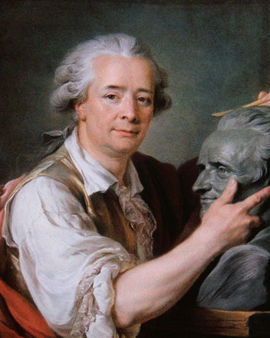In the heart of Paris, in 1730, the adventure of a lifetime began for Augustin Pajou, a master of classicist sculpture. At 14, he began his studies at the Academy Royal under the tutelage of sculptor Jean-Baptiste Lemoyne. At 18, his exceptional talent was demonstrated in the form of the Prix de Rome and the 1st Prize of the Akademie Royal, which opened the doors for him to study extensively in Rome and Italy.
Upon his return to France, a plethora of commissions awaited him, favored by the King and Madame du Barry. In the 1760s, he contributed significantly to the design of several public buildings, including the Versailles Opera House, the Palais Royal and the Palais de Justice. His artistic contribution is also reflected today in the stunning fine art prints of his work. Pajou was also active during the French Revolution, serving on a commission to preserve French monuments. When Napoleon made the Villa Medici in Rome the seat of the French Academy in 1803, he commissioned Pajou to make copies of the two Medici lions that stood at the stairway to the villa until 1789. Pajou's restoration of the lions in their original place is a living testament to his skill and contribution to the preservation of cultural heritage.
Among Pajou's most outstanding works are the busts of Buffon and Madame du Barry and a statuette of Bossuet, all of which can be admired in the Louvre. Equally notable is his collaboration on the "Fontaine des Innocents," where he created a series of new figures for Pierre Lescot's building, which was redesigned by Bernard Poyet. Pajou left behind not only a rich artistic legacy, but also a family. His son Jacques-Augustin-Catherine Pajou became a painter, and his daughter Catherine Flore Pajou, known as "Aunt Cocotte," married the sculptor Claude Michel before marrying Pierre-Louis Martin.
Augustin Pajou's artistic life is a story of ambition, talent and tireless dedication, which is evident in each of his works and, of course, its art prints. His work is preserved in the world's great museums, reminding us that art is a timeless legacy that is passed down from generation to generation.
×





_of_the_Barry_(1743-1793)_Sculpture_by_A_-_(MeisterDrucke-1030317).jpg)
_of_the_Barry_(1743-1793)_Sculpture_by_A_-_(MeisterDrucke-1030317).jpg)
 Count of Buffon 1773 (marble) - (MeisterDrucke-165050).jpg)
 Count of Buffon 1773 (marble) - (MeisterDrucke-165050).jpg)
 - (MeisterDrucke-223309).jpg)
 - (MeisterDrucke-223309).jpg)
_1791_Paris_Musee_du_Lou_-_(MeisterDrucke-946461).jpg)
_1791_Paris_Musee_du_Lou_-_(MeisterDrucke-946461).jpg)
 1773 (marble) - (MeisterDrucke-173816).jpg)
 1773 (marble) - (MeisterDrucke-173816).jpg)
_du_Barry_(1743-1793)_Marble_sculptu_-_(MeisterDrucke-988463).jpg)
_du_Barry_(1743-1793)_Marble_sculptu_-_(MeisterDrucke-988463).jpg)
.jpg)
.jpg)
.jpg)
.jpg)
.jpg)
.jpg)
 - (MeisterDrucke-223870).jpg)
 - (MeisterDrucke-223870).jpg)
.jpg)
.jpg)
_-_(MeisterDrucke-1528584).jpg)
_-_(MeisterDrucke-1528584).jpg)
 biscuit) - (MeisterDrucke-162065).jpg)
 biscuit) - (MeisterDrucke-162065).jpg)
.jpg)
.jpg)
.jpg)
.jpg)
.jpg)
.jpg)
.jpg)
.jpg)
.jpg)
.jpg)
.jpg)
.jpg)
 - (MeisterDrucke-202134).jpg)
 - (MeisterDrucke-202134).jpg)
.jpg)
.jpg)
.jpg)
.jpg)
.jpg)
.jpg)
.jpg)
.jpg)
.jpg)
.jpg)
.jpg)
.jpg)
.jpg)
.jpg)
.jpg)
.jpg)






